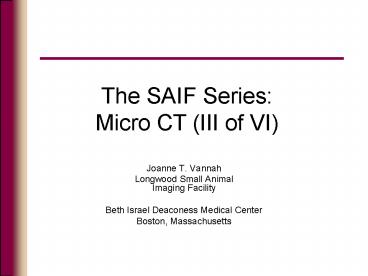Joanne T' Vannah PowerPoint PPT Presentation
1 / 28
Title: Joanne T' Vannah
1
The SAIF Series Micro CT (III of VI)
- Joanne T. Vannah
- Longwood Small Animal Imaging Facility
- Beth Israel Deaconess Medical Center
- Boston, Massachusetts
2
CT/CAT scans
- CT Computed tomography originally known as CAT
Computed axial Tomography - Tomography derived from the Greek root
tomos (slice) and graphia (to write) - Digital processing of X-ray data (2D) is used
to geometrically generate a 3D image
3
Strong penetrating ability of X-rays coupled with
spatial sectioning
4
CT x-Ray and detector (gantry) sit 180º from each
other
5
Micro CT x-ray detector standard components
- Scintillator screen of cesium iodide that
converts x-rays into light - An optical taper that concentrates the light onto
the camera - CCD camera records the image
6
Three possible interactions of x-rays (photons)
with matter
X-ray Energy 10- 500 keV
7
Photon-electron interactions
8
Attenuation 1/Penetration
9
The linear attenuation coefficient (µ) is the
signal measured
10
Calibration and Hounsfield units
- X-ray attenuation unit for interpreting CT data
- Calibrate with every scan to define relative
densities - Each pixel is assigned a value between 1K and
1K
11
Tomographic image 2D pixels correspond to 3D
voxels in subject
12
Series of rays projections
13
Tomographic reconstruction
- Transmission measurement, where the detector
measures an x-ray intensity, It - The unattenuated intensity of the x-ray beam is
also measured, Io - It Io e-µt
- t Thickness of subject along the ray
- µ average linear attenuation coefficient along
the ray - ln (I0/It) µt
14
Backprojection
Reconstruction algorithm produces image
15
Filtration
- The selective attenuation of photons depends upon
their energy - Photons lt10 keV, practically 0 penetration
- A value of 40 keV improves penetration
substantially - Lower keV for softer tissues, higher keV for
denser tissues (e.g., breast tissue compared to
bone)
16
Controlling x-ray beam intensity
LAC are energy dependent After passing through a
given thickness of subject, lower energies are
attenuated to a greater extent than higher energy
x-rays. Aluminum filter used.
17
Beam hardening
18
Comparing tissue of similar density
- The challenge arises when attempting to compare
tissues of similar composition - Not enough physical contrast to discern
differences - To increase image contrast a dense fluid with a
high atomic number may be used such as iodine
19
Micro CT scanners
Current Modality GE eXplore Locus Micro CT
Incoming Modality Siemens Inveon Micro
CT/SPECT/PET
Max res 15 µm Min scan time 1 12 cm bore
Max res 27µm Min scan time 6 9 cm bore
20
Scaling of dose for micro CT scans
- 1 rad 0.01 J/kg 0.01 Gy1 Gy 100 rad
- In any scan resolution, at 80 kV
- The standard dose delivered to mice is 2.1
mGy/mAs - The standard dose delivered to rats is 1.8
mGy/mAs - Compute mAs in a scan by multiplying the
following parameters - Number of views x number of frames x tube current
(milliamps) x integration time (seconds)
21
Typical rat scan
- 400 views
- 4 frames per view
- 450 microamp tube current
- 150 ms integration time
- 400 x 4 x 0.45 mA x 0.15s x 1.8 mGy/mAs 184 mGy
(or 0.184 Gy)
22
Micro CT experimental design
23
Micro CT applications
- Measure the change in density over time of
tissues, organs, and bones - Observe of osteoporosis and arterial hardening
- Quantify the healing of fractures
- Determine microcalcifications in breast cancer
tissue - Track adipose tissue (diabetic/nutrition) models
24
Calcified aorta in a transgenic mouse
25
Calcified aorta in a transgenic mouse
26
3D image of calcified aorta
A 3D volume rendering of a calcified aorta in a
transgenic mouse.
27
Pros/Cons for micro CT
- Pros
- Generation of 3D images
- Comparison of tissues of different composition
- High resolution
- Cons
- Comparison of similar tissues difficult to
distinguish - Use of radiation
28
Summary
- Micro CT is an efficient tool for monitoring the
change of density over time - The linear attenuation coefficient is the signal
being measured by the extent of x-ray interaction
with tissue - 2D x-ray images are geometrically computed to
produce a 3D image using a large data set

